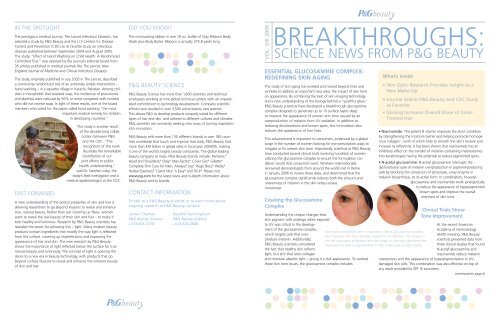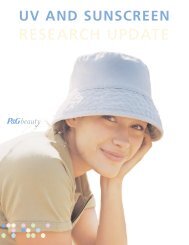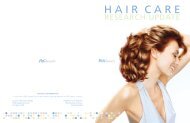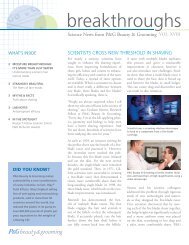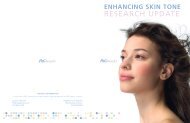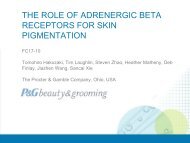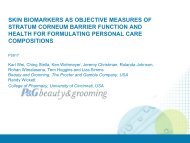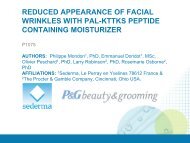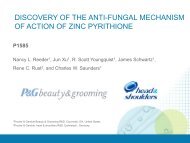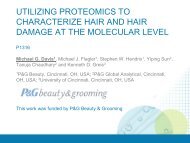BeautyScience_Newsletter_8.pdf - P&G Beauty & Grooming
BeautyScience_Newsletter_8.pdf - P&G Beauty & Grooming
BeautyScience_Newsletter_8.pdf - P&G Beauty & Grooming
You also want an ePaper? Increase the reach of your titles
YUMPU automatically turns print PDFs into web optimized ePapers that Google loves.
IN THE SPOTLIGHT<br />
The prestigious medical journal, The Lancet Infectious Diseases, has<br />
selected a study by P&G <strong>Beauty</strong> and the U.S Centers for Disease<br />
Control and Prevention (CDC) as its favorite study on infectious<br />
diseases published between September 2004 and August 2005.<br />
The study, “Effect of Hand Washing on Child Health: A Randomized<br />
Controlled Trial,” was selected by the journal’s editorial board from<br />
35 articles published in medical journals like The Lancet, New<br />
England Journal of Medicine and Clinical Infectious Diseases.<br />
The study, originally published in July 2005 in The Lancet, described<br />
a community randomized trial of an extremely simple intervention –<br />
hand washing – in a squatter village in Karachi, Pakistan. Among children<br />
in households that received soap, the incidences of pneumonia<br />
and diarrhea were reduced by 50% or more compared with controls<br />
who did not receive soap. In light of these results, one of the board<br />
members who voted for the paper called hand washing “the most<br />
important medical remedy for children<br />
in developing countries.”<br />
FAST FORWARD<br />
This study is another result<br />
of the decade-long collaboration<br />
between P&G<br />
and the CDC. “The<br />
recognition of this work<br />
illustrates the remarkable<br />
contribution of our<br />
joint efforts to public<br />
health understanding,”<br />
said Dr. Stephen Luby, the<br />
study’s lead investigator and a<br />
medical epidemiologist at the CDC.<br />
A new understanding of the optical properties of skin and hair is<br />
allowing researchers to go beyond illusions to reveal and enhance<br />
true, natural beauty. Rather than just covering up flaws, women<br />
want to reveal the real beauty of their skin and hair – to make it<br />
look healthy and luminous. Research by P&G <strong>Beauty</strong> scientists has<br />
revealed the secret for achieving this – light. Many modern beauty<br />
products contain ingredients that modify the way light is reflected<br />
from the surface, covering up imperfections and improving the<br />
appearance of hair and skin. The new research by P&G <strong>Beauty</strong><br />
shows the importance of light reflected below the surface for true<br />
natural beauty and luminosity. The concept of light is opening the<br />
doors to a new era in beauty technology, with products that go<br />
beyond surface illusions to reveal and enhance the inherent beauty<br />
of skin and hair.<br />
DID YOU KNOW?<br />
The moisturizing ribbon in one 18 oz. bottle of Olay Ribbons Body<br />
Wash plus Body Butter Ribbons is actually 375.8 yards long.<br />
P&G BEAUTY SCIENCE<br />
P&G <strong>Beauty</strong> Science has more than 1,800 scientists and technical<br />
employees working at nine global technical centers with an unparalleled<br />
commitment to technology development. Company scientific<br />
efforts have resulted in over 3,500 active beauty care patents.<br />
This allows P&G to develop products uniquely suited for different<br />
types of hair and skin, and tailored to different cultures and climates.<br />
P&G scientists are constantly seeking new ways of turning inspiration<br />
into innovation.<br />
P&G <strong>Beauty</strong> sells more than 130 different brands in over 180 countries<br />
worldwide that touch and improve lives daily. P&G <strong>Beauty</strong> had<br />
more than $19 billion in global sales in fiscal year 2004/05, making<br />
it one of the world’s largest beauty companies. The global leading<br />
beauty company at mass, P&G <strong>Beauty</strong> brands include: Pantene, ®<br />
Head and Shoulders, ® Olay, ® Max Factor, ® Cover Girl, ® Gillette ®<br />
Complete Skin Care for Men, Always, ® Joy, ® Hugo Boss, ® Wella, ®<br />
Herbal Essences, ® Clairol Nice ’n Easy ® and SK-II. ® Please visit<br />
www.pg.com for the latest news and in-depth information about<br />
P&G <strong>Beauty</strong> and its brands.<br />
CONTACT INFORMATION<br />
To talk to a P&G <strong>Beauty</strong> scientist or to learn more about<br />
ongoing research at P&G <strong>Beauty</strong>, contact:<br />
Lauren Thaman Heather Cunningham<br />
P&G <strong>Beauty</strong> Science P&G <strong>Beauty</strong> Science<br />
+513-626-1370 +513-626-2606<br />
VOL. VIII 2006<br />
BREAKTHROUGHS:<br />
SCIENCE NEWS FROM P&G BEAUTY<br />
ESSENTIAL GLUCOSAMINE COMPLEX:<br />
REDEFINING SKIN AGING<br />
The study of skin aging has evolved and moved beyond lines and<br />
wrinkles to address an important new area: the impact of skin tone<br />
on appearance. By combining the best of skin imaging technology<br />
and a new understanding of the biology behind a “youthful glow,”<br />
P&G <strong>Beauty</strong> scientists have developed a breakthrough glucosamine<br />
complex designed to penetrate up to 10 surface layers deep<br />
to improve the appearance of uneven skin tone caused by an<br />
overproduction of melanin from UV radiation. In addition to<br />
reducing discolorations and brown spots, this formulation also<br />
reduces the appearance of fine lines.<br />
This advancement is important to consumers, evidenced by a global<br />
surge in the number of women looking for non-prescription ways to<br />
mitigate or fix uneven skin tone. Importantly, scientists at P&G <strong>Beauty</strong><br />
have conducted several clinical trials involving hundreds of women<br />
utilizing the glucosamine complex to ensure the formulation can<br />
deliver results that consumers want. Nineteen internationally<br />
renowned dermatologists from around the world met in Rome<br />
in January 2006 to review these data, and determined that the<br />
glucosamine complex significantly reduces both the amount and<br />
unevenness of melanin in the skin versus a base<br />
moisturizer.<br />
Creating the Glucosamine<br />
Complex<br />
Understanding the unique changes that<br />
skin pigment cells undergo when exposed<br />
to UV was critical in the development<br />
of the glucosamine complex,<br />
which targets cells that overproduce<br />
melanin. Additionally,<br />
P&G <strong>Beauty</strong> scientists considered<br />
the fact that healthy skin reflects<br />
light, but skin that lacks collagen<br />
and moisture absorbs light – giving it a dull appearance. To combat<br />
these skin tone issues, the glucosamine complex includes:<br />
What’s Inside<br />
Extensive clinical trials were conducted to test a glucosamine complex<br />
that improves skin tone damage caused by UV radiation. The image on<br />
the left was taken at baseline and the image on the right represents the<br />
improvement seen in pigmentation in the circled area at eight weeks.<br />
• Skin Optic Research Provides Insight to a<br />
New Make-Up<br />
• Journal Selects P&G <strong>Beauty</strong> and CDC Study<br />
as Favorite<br />
• Glazing Increases Overall Shine of Color-<br />
Treated Hair<br />
• Niacinamide: This potent B vitamin improves the skin’s condition<br />
by strengthening the moisture barrier and helping promote homogenous<br />
collagen – both of which help to smooth the skin’s texture and<br />
increase its reflectivity. It has been shown that niacinamide has an<br />
inhibitory effect on the transfer of melanin-containing melanosomes<br />
into keratinocytes having the potential to reduce pigmented spots.<br />
• N-acetyl glucosamine: N-acetyl glucosamine interrupts the<br />
dysfunctional cycle of melanin overproduction in pigment-producing<br />
cells by blocking the conversion of tyrosinase, a key enzyme in<br />
melanin biosynthesis, to its active form. In combination, N-acetyl<br />
glucosamine and niacinamide work synergistically<br />
to reduce the appearance of hyperpigmented<br />
brown spots and improve the overall<br />
evenness of skin tone.<br />
Clinical Trials Show<br />
Tone Improvement<br />
At the recent American<br />
Academy of Dermatology<br />
(AAD) meeting, P&G <strong>Beauty</strong><br />
scientists presented data from<br />
three clinical studies that found<br />
N-acetyl glucosamine and<br />
niacinamide reduce melanin<br />
unevenness and the appearance of hyperpigmentation in UVdamaged<br />
skin cells. This combination was also effective on top of<br />
any result provided by SPF 15 sunscreen.<br />
(continued on page 2)
(continued from page 1)<br />
In Vitro Testing Shows Barrier Improvement,<br />
Collagen Growth<br />
Also at the AAD, P&G <strong>Beauty</strong> presented data from a study of in vitro<br />
human skin cultures that showed N-acetyl glucosamine and niacinamide<br />
act to stimulate hyaluronan synthesis, a key component in skin’s<br />
hydration, as well as increasing collagen production.<br />
Consumers get more radiant skin<br />
In order to assess how consumers felt about their appearance<br />
following the use of various products containing the glucosamine<br />
complex, P&G <strong>Beauty</strong> scientists conducted a blind study of nearly<br />
200 women who tried them. Eighty-seven percent of women<br />
surveyed found the products were effective at making their skin<br />
more radiant and luminous, and 77 percent said the products<br />
made their skin’s color and tone more even.<br />
“Pigmentation is an appearance issue that many women encounter.<br />
The large base clinical data indicate that the combination of N-acetyl<br />
glucosamine and niacinamide significantly evens skin tone, reduces<br />
the appearance of age spots, increases hydration and provides an<br />
easily accessible solution to ease women’s concern about aging,”<br />
says Dr. Rosemarie Osborne, Principal Scientist, P&G <strong>Beauty</strong>.<br />
Dr. Rosemarie Osborne,<br />
Principal Scientist at P&G <strong>Beauty</strong>, is an<br />
expert on the biological processes in<br />
skin that impact aging and appearance.<br />
Her study of N-acetyl glucosamine and<br />
niacinamide revealed that the complex<br />
stimulated biochemical messengers that<br />
help hydrate skin and prompt collagen<br />
growth – key aspects in skin health.<br />
P&G <strong>Beauty</strong> used its expertise in understanding skin optics to develop<br />
an age-defying foundation formula that breaks the trade-off between<br />
radiance and coverage. P&G <strong>Beauty</strong> scientists applied the understanding<br />
that light must be transmitted into the skin, diffused<br />
laterally and reflected back out again to get a youthful glow. They<br />
induce this optically by depositing a fluid film of make-up made<br />
discontinuous by translucent elastomer particles. After application,<br />
the liquid solidifies into a soft, flexible film that locks pigments in place,<br />
preventing them from drying, caking and migrating into areas of<br />
texture. In addition, the elastomer particles act as light lenses that<br />
actively channel light into and out of underlying skin, visibly brightening<br />
the skin. The film evenly distributes these texture-masking pigments<br />
with the elastomer light lenses to allow skin radiance to shine through.<br />
In consumer testing, the enhanced brightness and even skin tone has<br />
been shown to take up to five years off the appearance of facial skin.<br />
The image at left displays how conventional foundation prevents<br />
light from channeling through the skin. The image at right shows<br />
how translucent elastomer particles actively channel light into and<br />
out of mature skin with P&G <strong>Beauty</strong>’s foundation applied, increasing<br />
the brightness and youthful look of the skin.<br />
Mature skin also needs special care to enhance its health and appearance.<br />
The new foundation also leverages P&G <strong>Beauty</strong>’s expertise in<br />
moisturizing skin care to nourish and improve skin health over time.<br />
The foundation includes glycerine and niacinamide to improve skin<br />
hydration, antioxidants to help fight the aging affects of free radicals,<br />
and SPF 10 to protect skin from further photoaging. In fact, in vivo<br />
testing shows that the new foundation increases skin hydration by<br />
more than 50% even eight hours after application.<br />
STRANGELY BEAUTIFUL<br />
When light hits a rough, irregular surface, it scatters in all different<br />
directions in what scientists term diffuse reflection. Smooth surfaces –<br />
like mirrors – reflect light more sharply and uniformly. P&G <strong>Beauty</strong><br />
scientists know this law of physics also applies to hair, and they have<br />
developed products that make each strand reflect light like a tiny<br />
mirror. When hair is healthy, the cuticles, which cover the surface of<br />
each strand, overlap smoothly to reflect light more clearly, resulting<br />
in shiny hair that enhances the richness and brilliance of hair color.<br />
Damaged cuticles don’t lay flat, reflecting light diffusely and appearing<br />
dull. P&G <strong>Beauty</strong> has developed cuticle-protecting shampoos and<br />
conditioners that hydrate and protect color-treated hair to enable it<br />
to maximally reflect light and color expression.<br />
Dull Hair<br />
CLOSE-UP<br />
Shiny Hair<br />
The roughened cuticle of damaged hair (image, left) results in a<br />
duller shine. Uniform cuticles in healthy hair (image, right) cover<br />
the surface of every strand and reflect light more clearly and sharply,<br />
resulting in shinier hair.<br />
Color-boosting glazes have been used in the salon industry to<br />
boost color and shine between salon colors. But at-home versions<br />
have traditionally not offered long-lasting color benefits. P&G<br />
<strong>Beauty</strong> researchers learned that adding a substantive amino silicon<br />
conditioner after color glazing enhances overall shine and increases<br />
color retention by recreating the hair’s natural hydrophobic layer that<br />
was lost as a result of color treating.<br />
any marketable scent is equal parts art and science. The science<br />
comes from combining anywhere from 10 to 100 ingredients. The art<br />
comes from a variety of inspirational materials with which perfumers<br />
surround themselves. At P&G <strong>Beauty</strong>, the development process begins<br />
when a project manager briefs several internal perfumers on a new<br />
project. A design manager then guides scent development, monitors<br />
the work of the trained perfumers and evaluates the submissions.<br />
No fragrance leaves P&G <strong>Beauty</strong> without a thorough toxicological<br />
review and sensitization patch testing to ensure safety.<br />
MYTHS AND FACTS<br />
• Traditional anti-aging foundations make your skin<br />
look younger.<br />
MYTH – Most traditional anti-aging foundations make your<br />
skin look younger initially. However, the look only lasts as long<br />
as the make-up stays fresh and moist. As the make-up dries<br />
out, the pigments clump together, accentuating areas of<br />
texture and making skin look older. P&G <strong>Beauty</strong> has developed<br />
a breakthrough foundation formula designed to prevent<br />
pigments from drying out and clumping, making skin look<br />
up to five years younger even eight hours after application.<br />
• As skin ages it seems to lose its luminescent glow.<br />
FACT – New research into the optics of skin confirms that<br />
younger skin glows because it contains more collagen – which<br />
acts as a natural mirror, reflecting back more than 90% of the<br />
light entering the skin. Additionally, older skin contains more<br />
areas of hyperpigmentation, or “age spots,” which absorb<br />
light and prevent light from reflecting back out of the skin.<br />
COSMETIC TECHNOLOGY LEADS<br />
TO BREAKTHROUGH AGE-DEFYING<br />
LIQUID MAKE-UP<br />
Many women over 35 are looking for a make-up foundation that<br />
improves the youthful appearance as well as the underlying health<br />
of their skin. Between the ages of 16 and 35, the average woman<br />
loses 50 percent of her skin’s brightness and gains five times as many<br />
contrasting imperfections, resulting in older looking skin. Unfortunately,<br />
traditional foundations either improve radiance through light-reflecting<br />
particles or cover up skin imperfections with light-diffusing pigments –<br />
but not both. Even worse, imperfection-covering pigments can clump<br />
together over time, actually accentuating the wrinkles they were<br />
designed to mask.<br />
GLOBAL BEAUTY<br />
Moisturization is a universal indicator of the health and well-being<br />
of hair and skin. Women of African descent in particular crave more<br />
hydration for their hair and scalp than any other ethnic group. In a<br />
recent study among 1,000 African American women, a majority were<br />
concerned about dry, brittle hair (54%) and dry scalp (51%). Half of<br />
the women felt that dryness led to hair breakage. African American<br />
women go to great lengths to prevent hair and scalp dryness, including<br />
using moisturizing shampoos (71%), rinse-off conditioners (65%),<br />
leave-in conditioners (58%) and oil-based hair dressings (59%).<br />
To meet the needs of these hydration-hungry consumers, P&G <strong>Beauty</strong><br />
developed the world’s first petrolatum-depositing shampoo for maximum<br />
moisturization.<br />
The image on the left displays even deposits of the amino-siliconcontaining<br />
formulation on the hair, while the image on the right<br />
shows uneven deposits of film from a conventional glaze, which are<br />
more susceptible to color loss during shampooing.<br />
LAB NOTES<br />
Consumers have grown so accustomed to fragrances in beauty<br />
products that odorless shampoo has become a thing of the past.<br />
But transforming a fragrance-free white froth into, say, a revitalizing<br />
cucumber-melon experience is quite a complicated journey. Crafting


